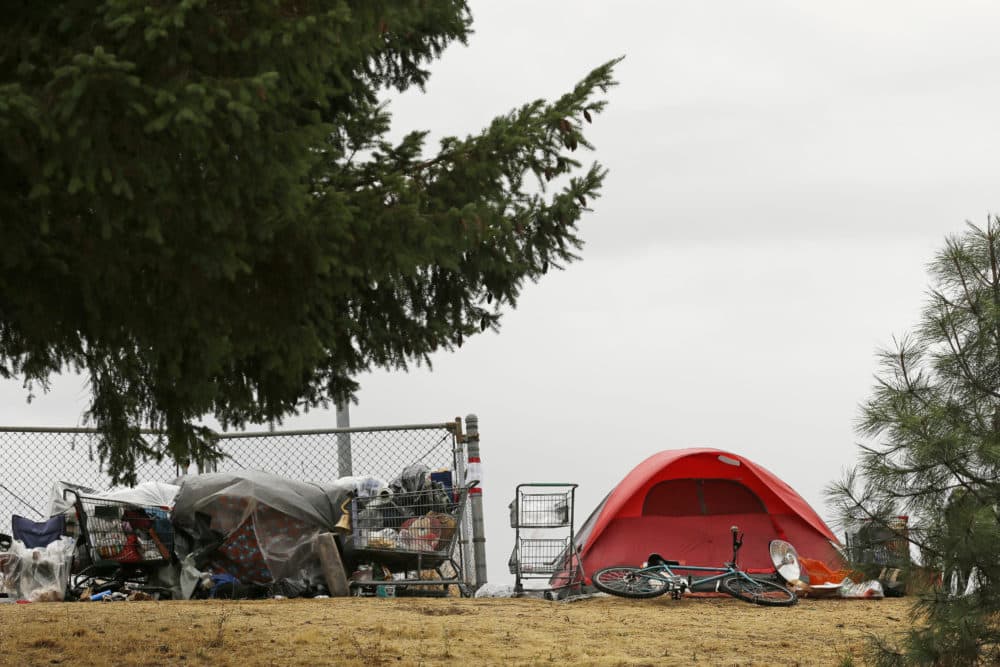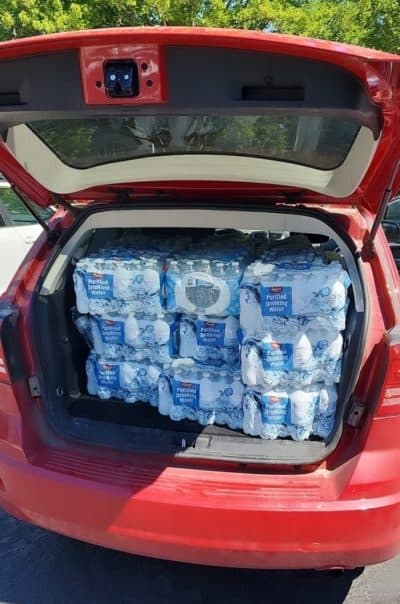Advertisement
How Extreme Heat Is Impacting The Homeless Community In Salem, Oregon

It's slightly cooler Wednesday in Oregon and Washington after a heat dome scorched the Pacific Northwest with triple-digit temperatures for several days.
As many as a dozen deaths may be tied to the heat, worrying folks who organize support services for the homeless community.
Jimmy Jones, executive director of a group called Mid-Willamette Community Action Agency in Salem, Oregon, says the 117-degree heat wave was a “devastating event” for a city that normally averages temperatures in the 80s this time of year. Many Pacific Northwesterns do not have air conditioning, he says, exacerbating the problem.
Before the dangerous heat this week started “baking us off the surface of the Earth,” Jones says a litany of issues has plagued Marion County — especially unhoused people in the area.
Over the last year, the county has faced the deadly pandemic, the Labor Day fires that burned 400,000 acres and ravaged 700 homes, and a tough winter that included an ice storm that impacted power for 70% of the county.

Now the record-setting heat wave is the latest in a string of very difficult events hitting the Salem community. Jones’ team opened up nine cooling centers around the city, arranged medical transports for unsheltered folks sweltering in the heat, and distributed almost 3,600 bottles of water and a thousand pounds of ice.
Despite the little forewarning before the heat crisis, Jones says “our deployment was actually really good” given the short notice.
Interview Highlights
On the homeless population in Salem
“Many of our homeless population here are chronically homeless. They've been homeless for quite some time. They have associated disabling conditions quite frequently [and] physical health conditions. We've just been through this year in which we've had an enormous number of people pass away — some passed away outside, some passed away because they got struck by a vehicle or some passed away from drug overdoses, some passed away from medical conditions in the hospital. We lost about 30 in the last year, which is about twice the normal number of folks that we lose. So at this moment, … [it] was incredibly difficult for our community.
“Folks are reticent to come into the cooling centers. They don't want to leave their encampments because they're afraid that their property may be stolen or someone may tear up their tent. They tend to wait a little bit too long sometimes. And we had quite a few heat-related medical problems with several people passing away in a neighboring community.”
Advertisement
On the heat-related deaths
“Well, in a neighboring town, Bend, Oregon, and it's a couple hours east of here, they had a couple of deaths there that were believed to be heat-related. Of course, it's sometimes hard to discern what the actual situation was this quickly. They're being investigated. We had a farm worker death in a small town called St. Paul not far from here. [We] had six people that we interacted with alone in the homeless community that we arranged for medical transport because they were in a state of distress from the environmental conditions. And then we have one report of one homeless individual living over here near the interstate who did pass away. I am a little bit hesitant to talk too much about that because I don't have all the details.
“... There was a sense of dread. A lot of times people don't take it seriously until it gets to be a very dangerous situation. So we saw a little bit of that — people having some reticence to come into cooling centers. We've been running cooling centers out here for about four years now, and they are always undersubscribed. People generally don't come to them unless they are in a state of real distress. We have a river that runs through the middle of Salem and a lot of people go down to the river to get into the water and get cool. So that's always been one of the common coping mechanisms and strategies the homeless population has when it comes to extreme weather events.”
On the significance of Oregon passing a bill that requires tracking the deaths of unsheltered people by including a note on their death certificate
“Well, it's very important, and it's one that I worked on quite consistently. There's just so much information out there that we don't have and so much information that the public doesn't have about the consequences of living in these unsheltered environments. And without that information, … it's real convenient to ignore this because that information sort of compels action. It suggests responsibility, and it encourages people to do something about just [the] insufferable human condition that people are quite frequently living in outside. I hope that it will lead to better social service outcomes down the road.”
On the impact of climate change on unhoused populations
“Generally when you look around the world at what the consequences of global warming have been already, populations that are being impacted the most and the first are the people in abject poverty, the people without adequate shelter, the people without adequate medical care, the people without the ability to seek safe shelter. And our situation in the West ... has just deteriorated in terms of the fires over the last 20 years. It is getting to be a graver and graver concern every year. I was just in a meeting with the Department of Human Services [Tuesday], and we were having conversations about what our plans are going to be for the upcoming fire season. These kinds of events that we're talking about here added on top of that, we can have very devastating consequences.”
On his team and the social work they do
“When you get into this work, there are a lot of different reactions to it. Some people care so much that after you see the kinds of human suffering that we see on a fairly regular basis, a lot of people just get burned out and they leave the work. They leave the profession, and they just can't take one more death. They can't take one more tragedy. They can't take one more story about the suffering that people experience in these unsheltered conditions. The other danger is, you know, you've lived through so much of it, you become kind of callous to it. You struggle to find empathy. So to be able to stay in the work long term, you have to find a balance between those two extremes to kind of keep going.
On the toll the pandemic took
“This is without a doubt been the most difficult year of all of our lives doing this work between COVID and, you know, a lot of our clients didn't end up getting the virus in Oregon because in part, we have so many unsheltered people living outside in a perfectly socially distanced environment. But at the same time, so many services got shut down and reduced access to medical care. It was more difficult. We operate day centers and normal capacity in the day centers around 80 people where we had to drop that to ten at one point in time. And eventually, it came back up to 20 and 25 and now 30. And now, as of [Wednesday], the governor has ended the emergency order here in Oregon. And, you know, basically the state is reopened. So we'll get back to a 100% capacity there.
“But COVID made everything so much harder. But then on top of that, we had the Labor Day fires. We had this terrible ice storm and a fairly rough winter overall. And then just four months later where the sun is baking us off the surface of the Earth. So this has been a really challenging 18 months, without a doubt.”
Ashley Locke produced and edited this interview for broadcast with Jill Ryan. Serena McMahon adapted it for the web.
This segment aired on June 30, 2021.
